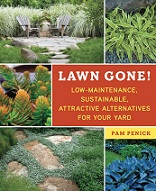Book Review: Lawn Gone! Low-Maintenance, Sustainable, Attractive Alternatives for Your Yard

Lawn Gone! Low-Maintenance, Sustainable, Attractive Alternatives for Your Yard
by Pam Penick
Ten Speed Press: 2013
ISBN 978-1-60774-314-9
eISBN 978-1-60774-315-6
Paperback: U.S. $19.99
eBook: U.S. $12.99
Potential Readers
- Anyone who wants a beautiful landscape despite low-water conditions
- Water conservationists interested in xeriscape
- Gardeners who live where conditions swing from hot and droughty to freezing and flooded
- Corporate and municipal landscape architects
- Homeowners who are tired of mowing lawns
Pam Penick was a frustrated gardener. None of the garden publications she liked to read talked about plant choices for the hot, droughty conditions -- briefly interrupted by annual monsoons and freezing rains -- that were common to her Central Texas home.
So Penick began to change the landscape of garden writing by blogging about xeriscape, the art of planting attractive waterwise gardens. Along the way, she became a professional landscaper and garden writer specializing in ways to minimize water-thirsty lawn while maximizing green and colorful yards. Lawn Gone is the result.
Lawn Gone redefines the traditional grassy suburban yard through replacement of all or parts of lawn with perennial groundcovers and small shrubs -- such as Autumn Sages (Salvia greggii spp.) and Anise Scented Sages (Salvia guaranitica) -- as well as ornamental grasses, sedges and hardscape, including water features.
For those who have never landscaped with water features, one of the aha moments in Penick's book is that ponds and fountains consume less replacement water weekly than the amount of lawn they replace.
Additionally, water features require less maintenance than weekly mowing. Penick points out that they are also beneficial for small wildlife and humans alike. Adding a pump to a small pond creates the "music and dance of moving water," she writes.
Although Penick includes plant choices for all regions of the nation, gardeners in perennially dry regions may find her suggestions most useful. For example, anyone who lives where summer wildfires are a threat will appreciate the section on fire-resistant landscapes.
Other thoughtful chapters in Lawn Gone concern how to deal with local zoning codes, homeowner associations and "skeptical neighbors" regarding waterwise replacement of grassy expanses. Lawn lovers are more accepting of xeriscape and yards designed as wildlife habitat when good communication exists between neighbors.
We highly recommend Lawn Gone as a good read and a book full of ideas for conserving water, limiting time mowing grass, maximizing color in the garden, and creating attractive hardscape.
If you have questions about additional sages to add to your landscape when cutting back on turf, please call or write to us at Flowers by the Sea. We love to share landscaping ideas.

Comments
There are no comments yet.